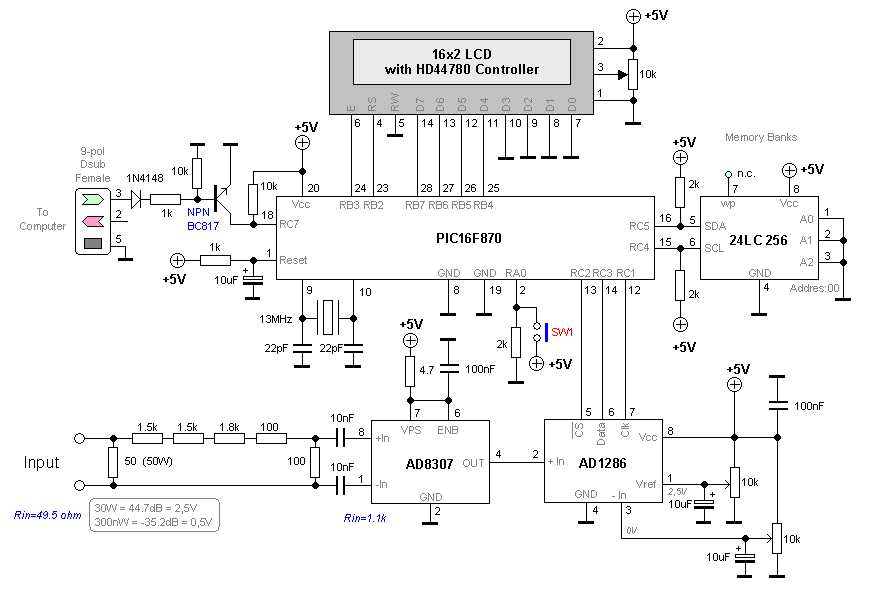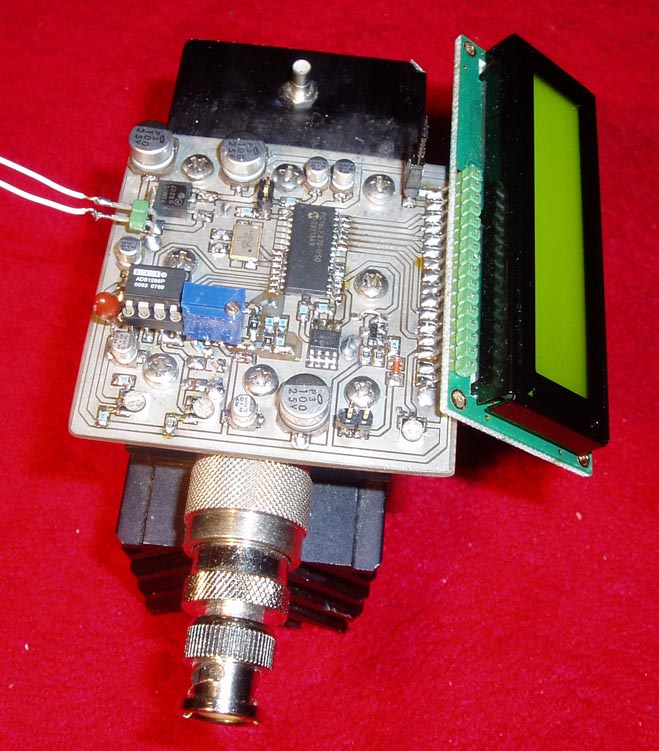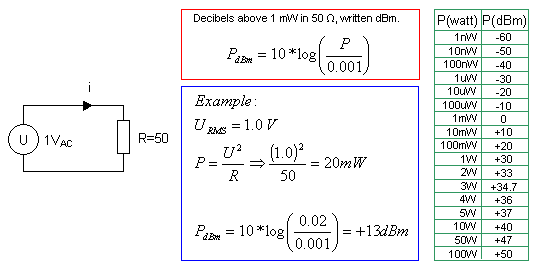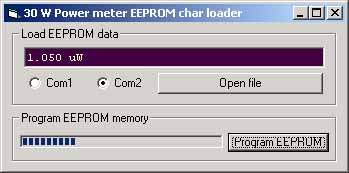| |
This project will explain how I build my new wattmeter.
This watt meter will be able to measure power from 300nW to 30W @ (0-500MHz).
This wattmeter is based up on a dummy load of 50 ohm which can handle 50W.
The measurement will be displayed in Watt on a 2x16 Char display.

Background
This watt meter project is very similar to my last wattmeter project. The main reason I made a new project is becasue I needed a unit which could handle higher power than 1W. I found a 50 ohm dummy load which could take 50W of power. Of course I could use attenuates for my 1W meter, but I prefered to build a new unit. The new thing with this project is that it will only display the power in Watt on the LCD display. This means that I will not need so many EEPROM to store display data (more about this later).
First we need to update our knowledge how to measure RF power: Some figures and text comes from my last wattmeter project, but it can be good to read it to remember.
How you calculate power
Above you can see a AC generator and a resistor of 50 ohm. A current will flow in the circuit and you can easy calculate the effect which will be consumed by the resistor. The effect will be transformed into heat. In the blue frame you can see how I calculate the power to 20mW. The red frame show how you can calculate the power into dBm, which which stand for decibels above 1 mW in 50 ohm, written dBm.
In the green table at rigth I have calculated some power into PdBm.
The input power is measured by the circuit AD8307. A resistor ladder will divide down the power to proper range for the AD8307 circuit. An A/D converter of 12 bit convert the analogue output from the AD8307 to a digital number. Since the AD is a12 bit A/D you will have 4096 combinations. The output values will be from 0 to 4095. Since the AD8307 gives a analogue voltage which represent the (dBm) of the input power, we need to recalculate the value to get the power in watt. The dBm is a logarithmic scale and that would include lot of math (floating point in the PIC processor) so I have chosen the easy way and used a lookup table instead. It is memory bank containing all the display text. I have pre-calculated all the display text for each A/D value. The output values from the AD (0 to 4095) points to a direction in the memory where the actual display text value is stored. The text will be fetched and presented on the display.
The advantage of using a memory map is that it will be easy to build, I can implement prefix in the text, it will be fast and it will work!
In reality I will use 1 EEPROM of 32k. The EEPROM is cheap but there is one tricky thing to do. The memory table must be programmed into the EEPROM before it can be used. You simply connect a RS232 cable to a computer and use a program I will support you with. This program will handle everything, just start the program and go make yourself a cup of coffee. Every memory cell will take 10-20ms to burn so it will take 10-15min.
Once the EEPROM has been programmed you will not have to do this again.
Hardware and schematic
Click here to view a larger schematic Let's look at the schematic at the RF-Input.
Directly connected over the input is a 50 ohm (dummy) resistor which can handle 50w.
Then you will see 5 resistors forming a voltage divider to the AD8307.
The resistors are 1.5k +1.5k +1.8k +100 + 100.
How does all this work?
Well, the AD8307 is actually a voltage RF measuring circuit.
In the datasheet of AD8307, you will see that 10mW RF input into 50 ohm is equal to 10dBm and will give 2.5V DC out of the circuit.
Now, which voltage will give 10mW into 50 ohm?
P=U2/R => 0.01 = U2/50 => U = 0.707V. Now, we know that 0.707V RF input will give 2.5V DC out of the circuit.
I my schematic I have used a 100 ohm resistor over (+In and -In). We must not forget that the circuit iself has an input resistance of 1.1k ohm.
So let's start calculating backwards and have some brain exercise...*lol*
1.1k//100 = 91.66 ohm. Let us now calculate the input resistance which the RF signal will see.
Rin =50//(1.5k+1.5k+1.8k+100+91.66) = 49.50 ohm...pretty good match.
If I put 30W into this system the voltage over the input would be: P=U2/R => 30 = U2/49.50 => 38.54 V
To get a 2.5V DC out of the AD7307 (which was equal to 0.707V RF-in), We have to scale down the 38.54V to the 0.707V.
38.54/0.707 = 54.5 times.
Photo of display of the the 30W meter. Since the Rin was 91.66 ohm we can calculate the scaling resistor of the ladder.
Scale = (Rladder + 91.66)/91.66 = > Rladder should be 4904 ohm.
In my case I use 1.5k + 1.5k + 1.8k + 100 = 4900 ohm....pretty good match.
Puhhhh, that was some bori...basic math, lets move on to more fun stuff :-)
The output signal from the AD8307 goes to an A/D circuit which are controlled by the PIC16F870.
To the PIC is an EEPROM connected. This EEPROM will contain the look-up table for the display.
The display in this project is a basic 2 line and 16 char LCD display based on a HD44780 controller circuit (most common).
As I told you earlier, the EEPROM must be programmed from a computer to make this unit work properly. The connection to a computer is done by a RS232 wire. The programming procedure is very simple: Start the main program in the computer and connect the RS232 wire to the wattmeter.
Before you turn on the power of the wattmeter you should make sure that the switch SW1 is closed.
This will indicate the PIC that it should program the EEPROM.
Now turn on the power and hit the button of the software called "Program EEPROM".
Everything will now be automatically. When program is finished you should turn off the power and remove SW1. The unit is now ready to be used.
Windows Software
This is the software to load the EEPROM. This is the Window software I use to load the EEPROM. The software is quit simple. Connect the wattmeter to the the computer via RS232-cable. Choose Com1 or Com2. Click Open file button and choose the file called "data.txt" which contains the pre calculated table.
When the EEPROM i loaded the wattmeter will go into normal mode and display the actual power.
The PIC and windows software is zipped (software + data.txt) and can be download by links below:




|
|
|
| |
Accurate LC Meter
Build your own Accurate LC Meter (Capacitance Inductance Meter) and start making your own coils and inductors. This LC Meter allows to measure incredibly small inductances making it perfect tool for making all types of RF coils and inductors. LC Meter can measure inductances starting from 10nH - 1000nH, 1uH - 1000uH, 1mH - 100mH and capacitances from 0.1pF up to 900nF. The circuit includes an auto ranging as well as reset switch and produces very accurate and stable readings. |
|
PIC Volt Ampere Meter
Volt Ampere Meter measures voltage of 0-70V or 0-500V with 100mV resolution and current consumption 0-10A or more with 10mA resolution. The meter is a perfect addition to any power supply, battery chargers and other electronic projects where voltage and current must be monitored. The meter uses PIC16F876A microcontroller with 16x2 backlighted LCD. |
|
|
|
60MHz Frequency Meter / Counter
Frequency Meter / Counter measures frequency from 10Hz to 60MHz with 10Hz resolution. It is a very useful bench test equipment for testing and finding out the frequency of various devices with unknown frequency such as oscillators, radio receivers, transmitters, function generators, crystals, etc. |
|
1Hz - 2MHz XR2206 Function Generator
1Hz - 2MHz XR2206 Function Generator produces high quality sine, square and triangle waveforms of high-stability and accuracy. The output waveforms can be both amplitude and frequency modulated. Output of 1Hz - 2MHz XR2206 Function Generator can be connected directly to 60MHz Counter for setting precise frequency output. |
|
|
|
BA1404 HI-FI Stereo FM Transmitter
Be "On Air" with your own radio station! BA1404 HI-FI Stereo FM Transmitter broadcasts high quality stereo signal in 88MHz - 108MHz FM band. It can be connected to any type of stereo audio source such as iPod, Computer, Laptop, CD Player, Walkman, Television, Satellite Receiver, Tape Deck or other stereo system to transmit stereo sound with excellent clarity throughout your home, office, yard or camp ground. |
|
USB IO Board
USB IO Board is a tiny spectacular little development board / parallel port replacement featuring PIC18F2455/PIC18F2550 microcontroller. USB IO Board is compatible with Windows / Mac OSX / Linux computers. When attached to Windows IO board will show up as RS232 COM port. You can control 16 individual microcontroller I/O pins by sending simple serial commands. USB IO Board is self-powered by USB port and can provide up to 500mA for electronic projects. USB IO Board is breadboard compatible. |
|
|
|
|
ESR Meter / Capacitance / Inductance / Transistor Tester Kit
ESR Meter kit is an amazing multimeter that measures ESR values, capacitance (100pF - 20,000uF), inductance, resistance (0.1 Ohm - 20 MOhm), tests many different types of transistors such as NPN, PNP, FETs, MOSFETs, Thyristors, SCRs, Triacs and many types of diodes. It also analyzes transistor's characteristics such as voltage and gain. It is an irreplaceable tool for troubleshooting and repairing electronic equipment by determining performance and health of electrolytic capacitors. Unlike other ESR Meters that only measure ESR value this one measures capacitor's ESR value as well as its capacitance all at the same time. |
|
Audiophile Headphone Amplifier Kit
Audiophile headphone amplifier kit includes high quality audio grade components such as Burr Brown OPA2134 opamp, ALPS volume control potentiometer, Ti TLE2426 rail splitter, Ultra-Low ESR 220uF/25V Panasonic FM filtering capacitors, High quality WIMA input and decoupling capacitors and Vishay Dale resistors. 8-DIP machined IC socket allows to swap OPA2134 with many other dual opamp chips such as OPA2132, OPA2227, OPA2228, dual OPA132, OPA627, etc. Headphone amplifier is small enough to fit in Altoids tin box, and thanks to low power consumption may be supplied from a single 9V battery. |
|
|
|
|
|
Arduino Prototype Kit
Arduino Prototype is a spectacular development board fully compatible with Arduino Pro. It's breadboard compatible so it can be plugged into a breadboard for quick prototyping, and it has VCC & GND power pins available on both sides of PCB. It's small, power efficient, yet customizable through onboard 2 x 7 perfboard that can be used for connecting various sensors and connectors. Arduino Prototype uses all standard through-hole components for easy construction, two of which are hidden underneath IC socket. Board features 28-PIN DIP IC socket, user replaceable ATmega328 microcontroller flashed with Arduino bootloader, 16MHz crystal resonator and a reset switch. It has 14 digital input/output pins (0-13) of which 6 can be used as PWM outputs and 6 analog inputs (A0-A5). Arduino sketches are uploaded through any USB-Serial adapter connected to 6-PIN ICSP female header. Board is supplied by 2-5V voltage and may be powered by a battery such as Lithium Ion cell, two AA cells, external power supply or USB power adapter. |
|
200m 4-Channel 433MHz Wireless RF Remote Control
Having the ability to control various appliances inside or outside of your house wirelessly is a huge convenience, and can make your life much easier and fun. RF remote control provides long range of up to 200m / 650ft and can find many uses for controlling different devices, and it works even through the walls. You can control lights, fans, AC system, computer, printer, amplifier, robots, garage door, security systems, motor-driven curtains, motorized window blinds, door locks, sprinklers, motorized projection screens and anything else you can think of. |
|
|
|